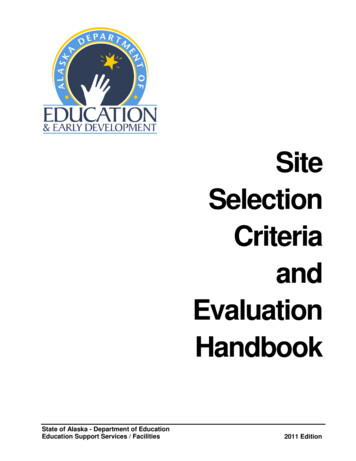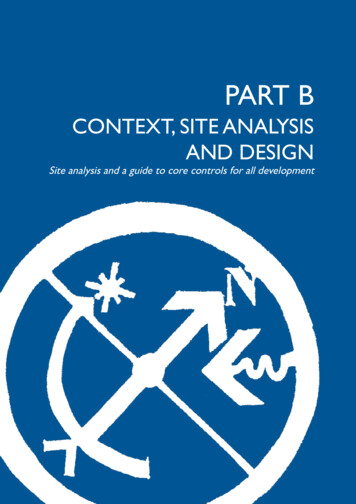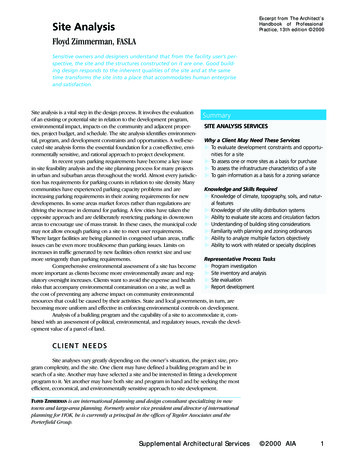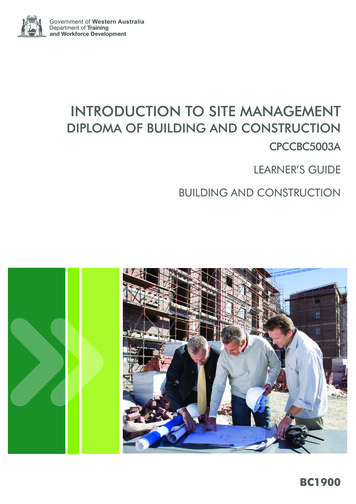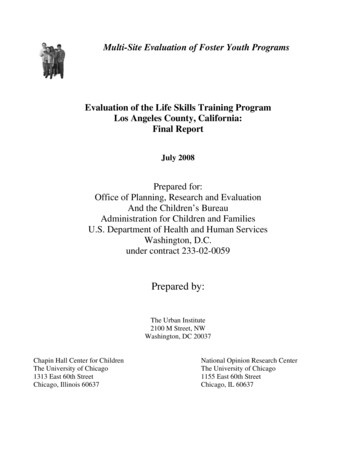
Transcription
Multi-Site Evaluation of Foster Youth ProgramsEvaluation of the Life Skills Training ProgramLos Angeles County, California:Final ReportJuly 2008Prepared for:Office of Planning, Research and EvaluationAnd the Children’s BureauAdministration for Children and FamiliesU.S. Department of Health and Human ServicesWashington, D.C.under contract 233-02-0059Prepared by:The Urban Institute2100 M Street, NWWashington, DC 20037Chapin Hall Center for ChildrenThe University of Chicago1313 East 60th StreetChicago, Illinois 60637National Opinion Research CenterThe University of Chicago1155 East 60th StreetChicago, IL 60637
Multi-Site Evaluation of Foster Youth ProgramsEvaluation of the Life Skills Training ProgramLos Angeles County, California:Final ReportPrepared by:Mark E. Courtney, Ph.D.Andrew Zinn, Ph.D.(Impact Findings)Erica H. Zielewski, M.P.P.Roseana J. Bess, M.P.P.Karin E. Malm, M.S.(Process Findings)Contributing Authors:Matthew Stagner, Ph.D.Michael Pergamit, Ph.D.
AcknowledgmentsThis report of the Multi-Site Evaluation of Foster Youth Programs focuses on impact findings from the LosAngeles Life Skills Training Program. This report, the first of four, represents many years of hard work anddedication of the Federal Project Officer, Maria Woolverton, and the many staff and administrators in LosAngeles’ Department of Children and Family Services and The Community College Foundation. We would alsolike to thank our previous project officer, Cassandra Simmel. We also want to extend our thanks to Mary BruceWebb and Naomi Goldstein of the Office of Planning, Research, and Evaluation, who provided substantial inputand support as we faced challenges to the evaluation.We want to acknowledge the professionalism and dedication of our research team. In particular, we want tothank our Los Angeles site survey manager, Diane Preciado. Together with Alma Kuby and Sarah Hughes at theNational Opinion Research Center, Diane worked enthusiastically to follow up with foster youth across LosAngeles County. In addition, we wish to thank many researchers who were part of the evaluation team in theearlier years of the study. John Schuerman, formerly with Chapin Hall, was instrumental in the overall studydesign and presentation of impact findings. Rob Geen, formerly with the Urban Institute, was instrumental in thedesign of the process study. Sherri Terao and Joseph West, formerly with Chapin Hall, were an integral part ofthe site visit team in Los Angeles. Cynthia Scarcella and Elizabeth Harbison, both formerly with the UrbanInstitute, worked diligently collecting and presenting Life Skills Training Program data. Heidi Johnson,currently with the Urban Institute, has provided extensive support in editing and finalizing this report. Lastly,Marv Eisen, formerly with the Urban Institute, provided and continues to provide invaluable insights andexpertise to the evaluation team.We also want to thank the external advisors who helped us along the way, particularly, the members of thestudy’s Technical Work Group. Your input on site recruitment, evaluation design, measures, and programmaticchallenges helped tremendously over the years.Finally, we want to extend a special thanks to all the youth who participated in the study. Their contributions oftime and information over the past several years are greatly appreciated. The views expressed in the report arethose of the authors and do not necessarily reflect the official positions of the Administration for Children andFamilies.Suggested Citation:U.S. Department of Health and Human Services,Administration for Children and Families. (July 2008).Evaluation of the Life Skills Training Program: Los Angeles County.Washington, D.C.
Table of ContentsExecutive SummaryivDescription of the Life Skills Training ProgramivThe EvaluationvImpact FindingsvLessons for Independent Living ProgramsvChapter 1. Introduction1Introduction2Overview of Legislation and Evaluation Purpose3Program Site Selection4Research Questions6Research Design and MethodsImpact StudyProcess Study7710Evaluation Challenges12Report Organization12Chapter 2. Life Skills Training Program: Context, Description, and Operations13Introduction14Context for Evaluated ProgramState and Local DemographicsFoster Youths in Los Angeles CountyDepartment of Children and Family ServicesEmancipation Preparation and Independent Living ServicesThe Community College Foundation141415151517Program DescriptionContextual Logic ModelProgram Operations Logic ModelProgram StaffingReferral and Recruitment ProcessesServices Provided171819232527Programmatic Challenges and DiscussionAdherence to the Logic ModelChallenges to Service Provision293031Conclusion32Chapter 3. Evaluation Implementation33Introduction34Sample Overview and Interview Process34Service Take-Up35Impact of the Evaluation on the Program39Characteristics of the Evaluation SampleBaseline Characteristics by Overall Sample and Assignment Group4040i
Baseline Characteristics by Compliance with Assignment Group42Chapter 4. Impact Study Findings47Introduction48Analytic StrategyDifferences in Service Receipt and Youth CharacteristicsExtensions to Intent-to-Treat AnalysesRegression Models48494950Significance Levels51Evaluated Outcomes51Service Receipt among Sample Youths54Impact FindingsOutcomes at Second Follow-Up6161Conclusion63Chapter 5. Lessons for Independent Living Programs from the Evaluation of the Life Skills Training Program68References74Appendix A. Evaluation Methodology and Challenges79Introduction80LST SampleSample OverviewOut-of-Scope Youths808081Changes to TCCF Process83Response and Out-of-Scope RatesRetention in Follow-up Interviews8485Fielding the Youth SurveyRecruiting and Training InterviewersAdvance LettersInterviewing PriorityField PeriodRespondent PaymentsTelephone InterviewsIncarcerated Respondents8585868787878788Evaluation ChallengesDeriving the Study SampleImposing on Established Procedures at TCCFAdherence to the Random AssignmentWorking with the Foster Care PopulationThe Interviewing Process888889899092Appendix B. Los Angeles County Context94Introduction95California State Independent Living PoliciesIndependent Living EligibilityEmancipation Preparation959596Los Angeles County Independent Living Policies and ServicesPermanency Partners Program (P3)9696ii
Redesigning Emancipation Services in Los Angeles CountyChief Administrative OfficeLos Angeles County Economy and Efficiency CommissionEmancipation Program Design TeamEmancipation Program PartnershipCollaborative Efforts with Other OrganizationsAftercare Services97979899102103103Appendix C. LST Staff Roles and Responsibilities107Appendix D. OA Perspective Form and 10 Tangible Outcomes Form109Appendix E. Impact Study—Methodology and Additional Data112Introduction113Intent-to-Treat Analyses and ExtensionsIntent-to-TreatIntent-to-Treat Extensions113113114Measurement of PreparednessPreparedness Scale Items115115Covariates in Analyses116Additional Impact Analyses Tables117iii
Life Skills Training ProgramExecutive SummaryApproximately 510,000 children lived in out-of-home care on September 30, 2006, the most recentdate for which national estimates are available. In fiscal year 2006, over 26,000 youths remained incare until they were legally “emancipated” to “independent living,” usually due to reaching the age ofmajority or upon graduation from high school. On average, these youth have limited education andemployment experience, relatively poor mental and physical health, and a relatively high likelihood ofexperiencing unwanted outcomes such as homelessness, incarceration, and nonmarital pregnancy.The Foster Care Independence Act of 1999 amended Title IV-E to create the John Chafee Foster CareIndependence Program (CFCIP), giving states more funding and greater flexibility in providingsupport to youth making the transition to independent living. It also required evaluation of suchservices. The U.S. Department of Health and Human Services’ Children’s Bureau contracted with theUrban Institute and its partners—the Chapin Hall Center for Children and the National OpinionResearch Center at the University of Chicago—to conduct this evaluation. The goal of this study is todetermine the effects of the programs funded under CFCIP in achieving key outcomes for youth. Fourprograms are being evaluated under this contract. The subject of this report is the Life Skills Training(LST) program of Los Angeles County.1Description of the Life Skills Training ProgramThe Life Skills Training program is similar in many respects to services provided in numerouslocations throughout the United States (i.e., classroom- and practicum-based training), though there arespecial aspects as well. There is an extensive outreach component, and the community college localeenables youths to be served in their communities and also exposed to community college campuses.The program serves a large number of youth and was oversubscribed for service, having nearly twiceas many youths referred as program participants.The five-week curriculum consists of ten three-hour classes held twice a week in 19 communitycolleges throughout Los Angeles County. The program is based on seven state-adopted competencyskill areas: education, employment, daily living skills, survival skills, choices and consequences,interpersonal/social skills, and computer/Internet skills. Instructors have the flexibility to design theirown classes and activities, invite guest speakers, and use experiential methods to impart information.Pre- and post-test assessments are provided to evaluate whether a youth has made progress in skillacquisition. In addition, an outreach component is staffed with 20 full- and part-time workers dedicatedto recruiting youths into the classes. Outreach advisors are responsible for recruiting youths, providingshort-term case management, and documenting services. Outreach advisors assess the youths with theAnsell-Casey assessment tool as well as other tools at the beginning and end of the class modules.1The Life Skills Training Program offered through the Community College Foundation is not related to or based on theLifeSkills Training substance abuse prevention program.iv
The EvaluationThe evaluation consists of two components: an impact study involving three in-person interviews overtwo years and a process study. The sample consists of youths who were in out-of-home careplacements and were 17 years old at the time of assignment, eligible for Chafee services, and deemedappropriate for Life Skills Training. A total of 482 youths were deemed eligible for the evaluation and234 were assigned to the LST (treatment) group, while 248 youths were assigned to the control group.At the baseline, 97 percent of eligible cases were interviewed, and 88 percent of these wereinterviewed at the second follow-up. Overall, 76.5 percent of the 234 youths in the LST group enrolledin an LST classroom module, 70.1 percent attended a session, and 65 percent graduated from amodule.As in other field experiments involving social services where the control over program receipt is notcomplete, some members of the control group received services (e.g., attended one or more LST classsessions). Specifically, according to administrative records, 26.6 percent of the 248 youths in thecontrol group enrolled in the program, 25 percent attended at least one class, and 22.6 percentgraduated from the program. The levels of reported receipt of most independent living services by thesecond follow-up did not differ significantly between assignment groups.Impact FindingsConcrete measures of the transition to adulthood were examined. Education and employment measuresinclude completion of a high school diploma or general equivalency diploma and current employmentstatus. Economic well-being was measured by reported earnings and current net worth, economichardship, and receipt of formal and informal financial assistance. Youths were also asked howprepared they felt in 18 areas of adult living and in obtaining a job. Finally, the evaluation consideredyouths’ housing, including residential stability and homelessness, as well as delinquency, pregnancy,and receipt of needed documentation (e.g., Social Security card) and accounts (e.g., a bank or savingsaccount).The impact evaluation found few impacts on any outcome assessed. After adjusting significance levelsto account for the possibility of false positive results, no significant impacts remained. While theproblems encountered in trying to conduct a random-assignment evaluation of LST require morecomplex analyses than would be the case if the evaluation had fewer violations of random assignment,the evaluation findings give no reason to believe that LST had a significant positive impact on any ofthe concrete indicators of successful transition to adulthood (e.g., educational attainment, employment,earnings, and avoidance of economic hardship).Lessons for Independent Living ProgramsThe large percentage of foster youths who reported receipt of help in acquiring various kinds of lifeskills from sources other than LST calls into question whether classroom-based life skills training canadd much to what foster youths are already obtaining from other sources. In addition, for most youths,it appears that independent living assistance comes from a variety of sources. Although the mostcommonly reported sources of independent living assistance included biological parents or otheroriginal family members and teachers and schools, sizable proportions of youths reported receivingv
assistance from foster parents, caseworkers, and independent living programs. Child welfareauthorities would be wise to assess how available these other sources of help are to youth in theirjurisdictions when considering investing in classroom-based life skills training.The evaluation calls into question the notion that classroom-based life skills training, in and of itself, islikely to have much impact on the well-being of foster youth in transition to adulthood. Child welfareauthorities should not expect classroom-based life skills training to suffice as a strategy to preparefoster youth for adulthood.Our evaluation provides strong evidence that foster youth are already getting some of this kind of helpfrom their foster care providers, though there is room for improvement. Further research should beconducted to understand the degree to which foster youth acquire independent living skills from theircaregivers and whether knowledge thus gained is more enduring than knowledge gained throughclassroom-based training. In addition, promising approaches to training foster care providers inteaching independent living skills and supporting them in such efforts should be rigorously evaluated.vi
Chapter 1. Introduction1
IntroductionApproximately 510,000 children lived in out-of-home care as of September 30, 2006, the mostrecent date for which national estimates are available (U.S. Department of Health and HumanServices [DHHS] 2008). This represents about six children and adolescents per thousand. Thevast majority of children and youth will exit care to what are considered permanent placements.Of the estimated 289,000 children who left out-of-home care in the United States during fiscalyear 2006, 86 percent went to live with family, were adopted, or were placed in the home of alegal guardian (DHHS 2008). A few (2 percent) were transferred to another public agency, suchas a probation or mental health department, and a few (2 percent) ran away and were dischargedfrom care. Nine percent, or 26,517, remained in care until they were legally “emancipated” to“independent living,” usually due to reaching the age of majority or upon graduation from highschool. In practice, few states allow youth to remain in care much past their 18th birthday(Bussey et al. 2000). About 5 percent (21,834) of all children and youths living in out-of-homecare were between 18 and 21 years old.Research findings suggest that the transition to adulthood for foster youth in the United States isdifficult. On average, they have had poor educational experiences, leading them to bring to thetransition very limited human capital upon which to build a career or economic assets. They alsooften suffer from mental health problems that can negatively affect other outcome domains, andthese problems are less likely to be treated once youth leave care. In addition, foster youthfrequently become involved in crime and with the justice and corrections systems after aging outof foster care. Further, their employment prospects are bleak, and few of them escape povertyduring the transition. At the same time, many former foster youth experience homelessness andhousing instability after leaving care. Compared with their peers, former foster youth have higherrates of out-of-wedlock parenting. Interestingly, in spite of court-ordered separation from theirfamilies, often for many years, most former foster youth rely on their families to some extentduring the transition to adulthood, though this is not always without risk (Barth 1990; Bussey etal. 2000; Cook, Fleischman, and Grimes 1991; Courtney et al. 2001; Courtney et al. 2005;Dworsky and Courtney 2000; Fanshel, Finch, and Grundy 1990; Festinger 1983; Frost and Jurich1983; Goerge et al. 2002; Harari 1980; Jones and Moses 1984; Mangine et al. 1990; Pecora et al.2005; Pettiford 1981; Sosin, Coulson, and Grossman 1988; Sosin, Piliavin, and Westerfeldt1990; Susser et al. 1991; Zimmerman 1982).These poor outcomes suggest the need for services to better prepare foster youth for thetransition to adulthood. Two decades ago, there were few such services. Numerous independentliving services have been developed since then as federal funding for independent living serviceshas increased. A recent review by Montgomery et al. (2006) found that no rigorous evaluationsof such services have been conducted. Rigorous evaluation of various independent livingservices is needed to inform efforts to improve their effectiveness.This report presents findings from a rigorous evaluation of the Life Skills Training Program(LST) in Los Angeles County.2,3 LST provides 30 hours of life skills training over five weeks to2The Life Skills Training Program is operated by The Community College Foundation (TCCF). TCCF is anonprofit organization in California that provides a range of programs to support educational technology,internship, scholarship, and at-risk youth initiatives. TCCF’s Human Development and Youth Services division2
foster youths ages 16 and older. The classes are held on community college campuses throughoutLos Angeles County. The program is staffed by workers tasked with conducting outreach toyouths to engage them in the program and providing some case management. We examine theprogram’s implementation and its impact on the youths served with a rigorous randomassignment method with a two-year follow-up. This is one of the impact reports from a four-sitestudy required by the Foster Care Independence Act of 1999, funded by the Children’s Bureauand directed by the Children’s Bureau and the Office of Planning, Research, and Evaluation inthe U.S. Department of Health and Human Services.This work is important for several reasons. First, the work confirms that youth who age out offoster care are not doing well and need further attention from the systems that have served thembefore they turned 18 years old. Second, child welfare systems can and should rigorously testinterventions using the best possible evaluation methods. It is possible to conduct rigorousevaluation in the child welfare system, and it is crucial to do so if the field is to develop servicesthat address the great needs of its children and youth. Finally, it is especially important to do thiswork now. The field has developed a significant number of new services in the past few decades,but without rigorous evaluation it is impossible to know what is truly helping the children andfamilies in the child welfare system.In the remainder of this chapter, we provide an overview of the Chafee legislation and theevaluation purpose, as well as site selection for the evaluation and research questions for thestudy. We also review the research design and methodology for both the impact and processstudies. In chapter 2, we describe the LST program using information obtained as part of theprocess study component of the evaluation. Chapter 3 provides an overview of the evaluation’simplementation, including a discussion of service take-up, sample development, and adescription of the sample. Results of the evaluation’s impact study are discussed in chapter 4. Adiscussion of process study findings that shed light on the impact findings is also presented inchapter 4. Finally, chapter 5 provides a discussion of the findings of the evaluation and how itrelates to the broader field of independent living programs.Overview of Legislation and Evaluation PurposeThe Foster Care Independence Act (FCIA) of 1999 (Public Law 106-169) amended Title IV-E ofthe Social Security Act to create the John Chafee Foster Care Independence Program (CFCIP),giving states more funding and greater flexibility in providing support for youth making thetransition to independent living. The FCIA allocates 140 million per year in independent livingservices funding to states, allows states to use up to 30 percent of these funds for room andboard, enables states to assist young adults between the ages of 18 and 21 who have left fostercare, and permits states to extend Medicaid eligibility to former foster children up to age 21.State performance is a much higher priority under the FCIA than under earlier iterations offederal policy in this area. The U.S. Department of Health and Human Services is required to3offers programs at 49 community colleges throughout the state, 19 of which are in Los Angeles County, andreaches more than 14,000 youths and adults annually.The Life Skills Training Program offered through The Community College Foundation is not related to or basedon the LifeSkills Training substance abuse prevention program.3
develop a set of outcome measures to assess state performance in managing independent livingprograms, and states are required to collect data on these outcomes. In addition, the FCIArequires that funding under the statute be set aside for evaluations of promising independentliving programs:The Secretary shall conduct evaluations of such State programs funded under thissection as the Secretary deems to be innovative or of potential nationalsignificance. The evaluation of any such program shall include information on theeffects of the program on education, employment, and personal development. Tothe maximum extent practicable, the evaluations shall be based on rigorousscientific standards including random assignment to treatment and control groups.The Secretary is encouraged to work directly with State and local governments todesign methods for conducting the evaluations, directly or by grant, contract, orcooperative agreement (Title IV-E, Section 477 [42 U.S.C. 677], g, 1).The language in the FCIA requiring rigorous evaluation of independent living programs reflectsthe acknowledgment by lawmakers that little is known about the effectiveness of independentliving programs. In response to this language, the Department of Health and Human Services’Children’s Bureau has contracted with the Urban Institute and its partners—the Chapin HallCenter for Children and the National Opinion Research Center—to conduct an evaluation ofselected programs funded through the CFCIP, the Multi-Site Evaluation of Foster YouthPrograms. The goal is to determine the effects of independent living programs funded underCFCIP in achieving key outcomes for participating youths, including increased educationalattainment, higher employment rates and stability, better interpersonal and relationship skills,fewer nonmarital pregnancies and births, and reduced rates of delinquency and crime.Program Site SelectionIn 2001, the Department of Health and Human Services contracted with the Urban Institute andits partners to conduct an evaluability assessment of independent living programs. The goal ofthis assessment was to identify programs that could be rigorously evaluated and to developevaluation designs that would meet the requirements of the authorizing legislation. Theevaluation team—in coordination with the Children’s Bureau and a federally-appointed technicalwork group—established criteria for selecting sites for the evaluability assessment. TheChildren’s Bureau selected programs to be evaluated.To be considered for the evaluation, programs were required to exhibit the following: Programs should take in sufficient numbers of youths to allow for the creation of aresearch sample of adequate size. Programs should have excess demand for services so that randomly assigning youths to acontrol group is possible while serving the same number of youths. Programs should be reasonably stable.4
Programs should be relatively intensive. Programs should have well-developed theories of intervention (“logic models”), linkingintended outcomes with intervention activities. Programs should be consistently implemented. Sites should have available data with which to understand the flow of clients and tofollow clients to assess key outcomes. Relevant decisionmakers should be willing to support participation in a rigorousevaluation. Program sites should be willing to make minor changes needed to accommodate theresearch and should be able to maintain them for the full research period.The evaluation team conducted this assessment to identify programs suitable for evaluationbetween October 2001 and January 2003 and involved the following: identifying independent living programs in the United States; developing information on critical aspects of these programs; categorizing the programs; selecting programs for further study; visiting the selected programs; applying the criteria for evaluability to selected programs; and recommending programs for evaluation.Thirty-two states and the District of Columbia were contacted and 87 different independentliving programs were examined. Site visits were conducted with the 23 programs that seemedmost promising. Most of the programs did not meet the basic criteria for evaluability; that is,most did not have sufficient program intake to allow the creation of a research sample ofadequate size or the excess demand that makes random assignment possible while serving thesame number of youths.Four independent living programs were selected for inclusion in the evaluation, which used arandom-assignment design. The selected programs encompass a set of critical independent livingservices and represent a range of program types. The programs include an employment servicesprogram in Kern County, California, modeled on Temporary Assistance for Needy Familieswork development assistance; an intensive case management and mentoring program in5
Massachusetts; a tutoring and mentoring program; and a classroom-based life skills trainingprogram, both serving youths in Los Angeles County. Note that these four programs are notrepresentative of all of the different types of independent living services available to youth in theUnited States. Rather, they represent a range of different interventions that independent livingprograms use. As a result, the findings from the Multi-Site Evaluation cannot be generalized toall independent living programs. It is also important to note that the study team attempted toidentify a housing program to evaluate and investigated several different housing programslocated throughout the country. However, low numbers of participants in these programs maderandom assignment difficult and would not provide sufficient samples for the analyses.The LST program provides a service (life skills training classes) commonly provided throughoutthe United States. Although LST may provide a typical set of services, there are unusual aspectsof the program that may provide useful information for other independent living programs. Atthe time of the evaluation, 19 community colleges throughout Los Angeles County offered theLST program, enabling youth to be served in their communities while being exposed tocommunity college campuses. The outreach component was unusual in that many life skillsprograms do not have staff dedicated to recruiting and engaging youth. The program had roughly20 full- and part-time staff members dedicated to recruiting youths into the classes. Aside fromprogrammatic aspects, the program was selected because of the large number of youths that itserves (nearly 600 annually at the time of the assessment). LST is an oversubscribed service,having nearly twice as many referrals as program participants.Research QuestionsIn addressing the goals of the Chafee legislation, the Multi-Site Evaluation addressed thefollowing research questions. Program impacts: What impact does access to the identified intervention have for youthcompared with similar youth who have access to standard services or “services as usual”on key outcomes like self-sufficiency and well-being (e.g., educational skills,interpersonal skills, living skills, employment skills, psychosocial well-being)? Program mission: How does the program identify its logic model? Does serviceimplementation follow the logic model and mission? Service implementation: How are services implemented? Who performs the servicedelivery? What is the training and experience of staff delivering services? Who is being served: What types of youth are being served? Is there an assessmentprotocol to determine the types and duration of services needed? Who is excluded? Dothe intended populations receive services? Program challenges: What are barriers to implementation?6
Policy variables: How might external community or state-level variables contribute tooutcomes achieved by progra
Ansell-Casey assessment tool as well as other tools at the beginning and end of the class modules. The Life Skills Training Program offered through the Community College Foundation is not related to or based on the Lif
